Common Hawker, Oak Hill
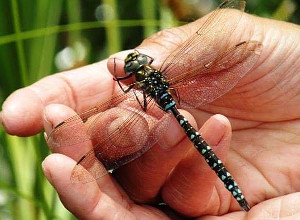
Photograph Oak Hill Group, 2017
Mayfly - Newton Mask
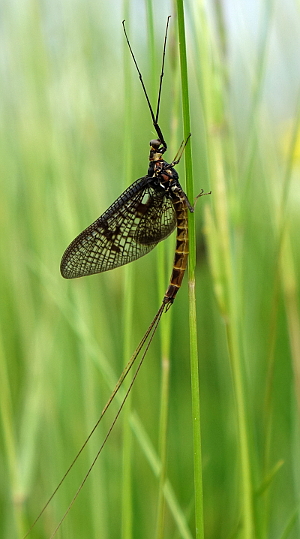
Photograph Helen Kitson, 2017
Banded Agrion - Newton Mask
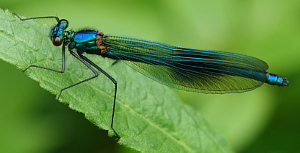
Photograph Helen Kitson, 2017
West Beck, 29 April 2017
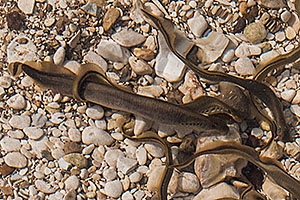 Eleven members, attended the meeting to explore the new Yorkshire Wildlife Trust sites at Snakeholme Pastures and Skerne Wetlands. Highlight of the day was the discovery of about a dozen brook lampreys spawning in Wanlass Drain. Apparently they spend the first three to five years of their life as filter feeders in the sediment before maturing. Soon after spawning the adults die. Notable birds included kingfisher, barn owl, marsh harrier, snipe and probable woodcock and wheatear. Our intention of walking from Snakeholme to Skerne Wetlands was thwarted by a drain with no bridge. YWT please note. The resultant diversion led to the discovery of a very interesting wood with early purple orchids, field rose and sanicle amongst others.
Eleven members, attended the meeting to explore the new Yorkshire Wildlife Trust sites at Snakeholme Pastures and Skerne Wetlands. Highlight of the day was the discovery of about a dozen brook lampreys spawning in Wanlass Drain. Apparently they spend the first three to five years of their life as filter feeders in the sediment before maturing. Soon after spawning the adults die. Notable birds included kingfisher, barn owl, marsh harrier, snipe and probable woodcock and wheatear. Our intention of walking from Snakeholme to Skerne Wetlands was thwarted by a drain with no bridge. YWT please note. The resultant diversion led to the discovery of a very interesting wood with early purple orchids, field rose and sanicle amongst others.
Andrew Chadwick, 29 April 2017
Brook Lamprey
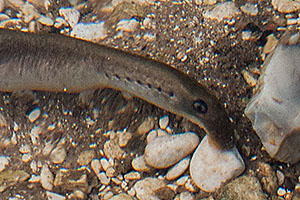
Photograph Andrew Chadwick 2017
Bronze Shieldbug
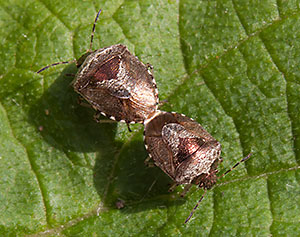 Wandering round the garden in the sunshine at the end of April, I spotted about ten bronze-coloured shield bug shaped insects, about 7mm long, on some Hedge Woundwort, many of them mating. While they were distracted, I took a photo or two. A quick search on the internet confirmed, maybe unsurprisingly, that they were called Bronze or Woundwort Shieldbugs, Eysarcoris venustissimus, and their favoured food plant was Hedge Woundwort. Sometimes life is straightforward.
Wandering round the garden in the sunshine at the end of April, I spotted about ten bronze-coloured shield bug shaped insects, about 7mm long, on some Hedge Woundwort, many of them mating. While they were distracted, I took a photo or two. A quick search on the internet confirmed, maybe unsurprisingly, that they were called Bronze or Woundwort Shieldbugs, Eysarcoris venustissimus, and their favoured food plant was Hedge Woundwort. Sometimes life is straightforward.
Andrew Chadwick, 30 April 2017
Greenhouse visitor
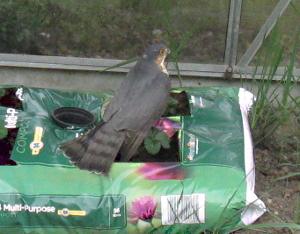 We were rather surprised to find this Sparrowhawk in our greenhouse; we usually get Toads …
We were rather surprised to find this Sparrowhawk in our greenhouse; we usually get Toads …
R & K Middleton, 14 March 2017
BSBI Plant Hunt
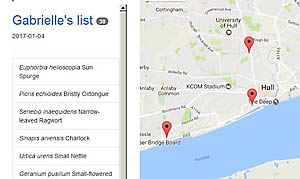 Botany needn't be confined to the summer months. If you are prepared to brave the weather it's surprising what you can find, even at the beginning of January. The BSBI New Year Plant Hunt is a challenge to record as many species in flower over a three hour period between 1st and 4th January. Gabrielle and Richard took part, gaining three markers for Hull on the results map, Gabrielle with lists of 38 and 32 species and Richard 22. For full details see the BSBI web site.
Botany needn't be confined to the summer months. If you are prepared to brave the weather it's surprising what you can find, even at the beginning of January. The BSBI New Year Plant Hunt is a challenge to record as many species in flower over a three hour period between 1st and 4th January. Gabrielle and Richard took part, gaining three markers for Hull on the results map, Gabrielle with lists of 38 and 32 species and Richard 22. For full details see the BSBI web site.
And the most frequent species? The daisy, Bellis perennis.
Andrew Chadwick, 6 January 2017
Green Shieldbug nymph - Oak Hill
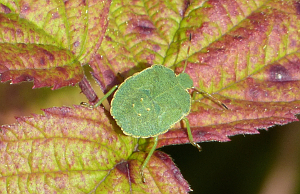
Photograph Andrew Ashworth, 2017
Six-spot Burnets & Forester,
Risby Warren
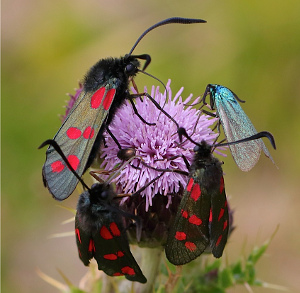
Photograph Andrew Ashworth, 2017
Antler Moth, Risby Warren
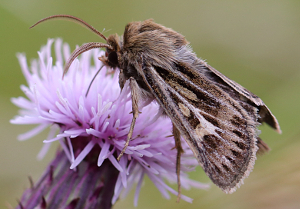
Photograph Andrew Ashworth, 2017
Geranium rotundifolium, Melton
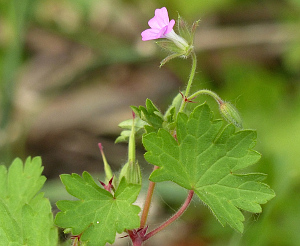
Photograph Andrew Ashworth, 2017
Young Great Tit, Melton
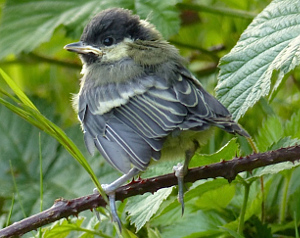
Photograph Andrew Ashworth, 2017
Garden visitor
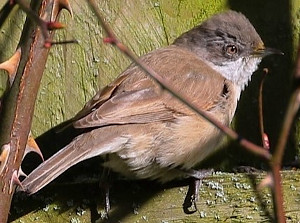 SIBERIAN LESSER WHITETHROAT
SIBERIAN LESSER WHITETHROAT
Sylvia curruca blythi
8th March -1st April 2017
ANDREW ASHWORTH
OS Grid: TA 05 32
This bird was first noticed in a Cottingham garden feeding on a fat ball feeder hanging in contact with large tree stump. It was subsequently seen within fairly small area of garden where a variety of bird feeders (fat balls, mixed seed, peanuts) attract typical suburban garden birds. The garden is relatively "wild" with native species planted such as small oak, birch, hazel and dog rose, together with evergreen non-native Berberis and Pyracantha near to the area.
Habit - Occasionally the bird would appear feeding alone, but more typically when other birds were present. Occasionally it would feed at a mixed seed feeder. More frequently it would use fat balls. Most frequently of all it would make a cautious approach through the trees, dropping in to the Berberis before then feeding on the ground, often in the company of Chaffinch or Dunnock, underneath seed feeders. Any disturbance at all and it would be quick to recede into the background and over the fence into a neighbour's garden. The bird would sometimes move from the feeding area making short flights of 1-2 metres or so bush to bush and on to the Pyracantha where it would hide before emerging to preen or rest.
On one occasion, whilst feeding at fatballs, it was aggressively displaced by a Robin which appeared to acquire and then drop a feather. A small fresh feather consistent in colour with the bird in question was found and sent to Martin Collinson in Aberdeen for DNA. DNA cytb sequence shows it to be of the race blythi 100% identical to multiple birds previously sequenced. The popular name for this race is Siberian Lesser Whitethroat.
Physical description - A small compact, short winged "Whitethroat", Sylvia sp. This bird always had the colour pattern more like the Whitethroat (Sylvia communis) than the nominate race of Lesser Whitethroat (Sylvia curruca curruca) that I am used to seeing in Britain.
Pale grey head, pale eye, whisp of a white supercilium. Dark mask typical of nominate race was usually not apparent but occasionally a hint was seen in certain light. The white throat was well delineated contrasting with pinky buff chest and abdomen. A "warm" even gingery brown mantle extended up the nape, with similarly brown wings. The tail showed full white outer tail feathers in flight but only seen briefly when tail fanned at the instant it took off. Bill and legs grey. Iris pale grey buff.
Thanks to Professor Collinson and also to the Robin that helped with the DNA sampling.
Andrew Ashworth, 17 May 2017
Orange Ladybird
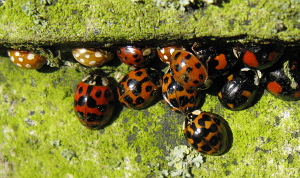 While visiting Hedon Road Cemetery yesterday I was struck by the large number of Harlequin Ladybirds packed into carved surfaces of some of the old and ornate gravestones. Amongst these groups were individuals of another species - the Orange Ladybird (Halyzia sedecimguttata), something I had not encountered before. (Three individuals in the above photograph)
While visiting Hedon Road Cemetery yesterday I was struck by the large number of Harlequin Ladybirds packed into carved surfaces of some of the old and ornate gravestones. Amongst these groups were individuals of another species - the Orange Ladybird (Halyzia sedecimguttata), something I had not encountered before. (Three individuals in the above photograph)
Unlike the Harlequin this species is a native. Once considered to be confined to ancient wooldand, in recent times it has adapted to feed on Sycamore and has increased markedly in abundance.
Richard Middleton, 16 March 2017
BSBI Plant Hunt (2)
Plants in flower were definitely harder to come by this year. Last year's hunt came after a period of mild wet weather, whereas at the end of 2016 we had a lengthy dry period followed by frosts and strong winds. Hence once productive patches of waste ground were scoured dry and only in very sheltered corners were leftover flowers clinging on. To add to which the grassy area at the bottom of Newland Ave and the Avenues generally had been forcibly "tidied up" and an eyesore "Welcome to Newland Avenue" sign almost obscured the Winter heliotrope on the embankment. So I concentrated my search on the disused railway line and the narrower streets and passages off Newland Avenue and in Sculcoates. Best finds were Shaggy Soldier outside Planet Coffee and Autumn Hawkbit on Beverley Rd. On my second walk from Priory Park and Ride I encountered similar problems - lots of tantalising dried seedheads, flowers needing the shelter of buildings or the warmth of heavy lorries passing. Best finds Blue Fleabane and Sticky Groundsel.
Gabrielle Jarvis, 6 January 2017



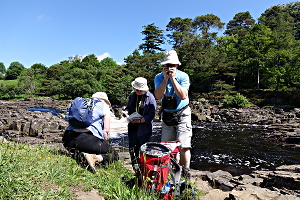

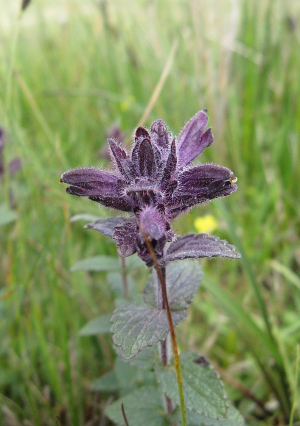
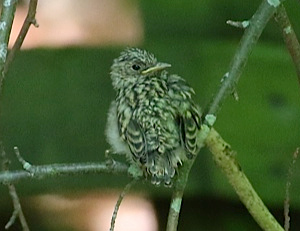
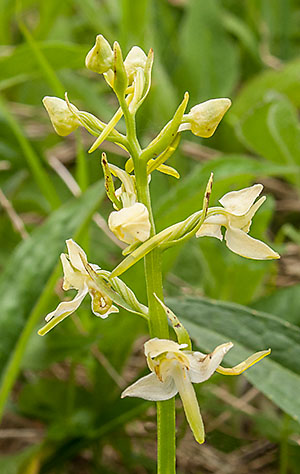
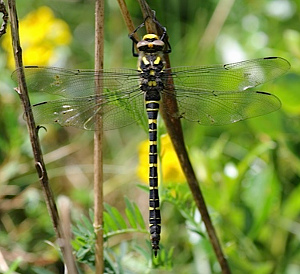
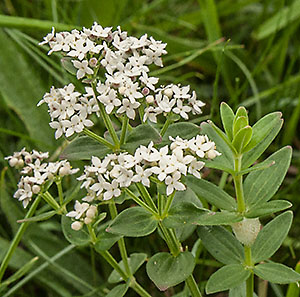
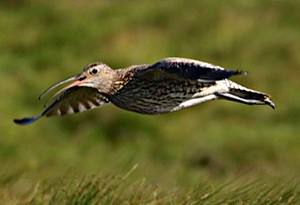
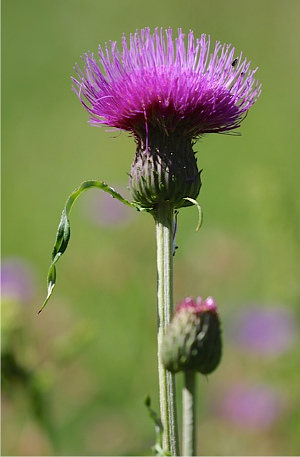



 Eleven members, attended the meeting to explore the new Yorkshire Wildlife Trust sites at Snakeholme Pastures and Skerne Wetlands. Highlight of the day was the discovery of about a dozen brook lampreys spawning in Wanlass Drain. Apparently they spend the first three to five years of their life as filter feeders in the sediment before maturing. Soon after spawning the adults die. Notable birds included kingfisher, barn owl, marsh harrier, snipe and probable woodcock and wheatear. Our intention of walking from Snakeholme to Skerne Wetlands was thwarted by a drain with no bridge. YWT please note. The resultant diversion led to the discovery of a very interesting wood with early purple orchids, field rose and sanicle amongst others.
Eleven members, attended the meeting to explore the new Yorkshire Wildlife Trust sites at Snakeholme Pastures and Skerne Wetlands. Highlight of the day was the discovery of about a dozen brook lampreys spawning in Wanlass Drain. Apparently they spend the first three to five years of their life as filter feeders in the sediment before maturing. Soon after spawning the adults die. Notable birds included kingfisher, barn owl, marsh harrier, snipe and probable woodcock and wheatear. Our intention of walking from Snakeholme to Skerne Wetlands was thwarted by a drain with no bridge. YWT please note. The resultant diversion led to the discovery of a very interesting wood with early purple orchids, field rose and sanicle amongst others.

 Wandering round the garden in the sunshine at the end of April, I spotted about ten bronze-coloured shield bug shaped insects, about 7mm long, on some Hedge Woundwort, many of them mating. While they were distracted, I took a photo or two. A quick search on the internet confirmed, maybe unsurprisingly, that they were called Bronze or Woundwort Shieldbugs, Eysarcoris venustissimus, and their favoured food plant was Hedge Woundwort. Sometimes life is straightforward.
Wandering round the garden in the sunshine at the end of April, I spotted about ten bronze-coloured shield bug shaped insects, about 7mm long, on some Hedge Woundwort, many of them mating. While they were distracted, I took a photo or two. A quick search on the internet confirmed, maybe unsurprisingly, that they were called Bronze or Woundwort Shieldbugs, Eysarcoris venustissimus, and their favoured food plant was Hedge Woundwort. Sometimes life is straightforward.
 We were rather surprised to find this Sparrowhawk in our greenhouse; we usually get Toads …
We were rather surprised to find this Sparrowhawk in our greenhouse; we usually get Toads …
 Botany needn't be confined to the summer months. If you are prepared to brave the weather it's surprising what you can find, even at the beginning of January. The BSBI New Year Plant Hunt is a challenge to record as many species in flower over a three hour period between 1st and 4th January. Gabrielle and Richard took part, gaining three markers for Hull on the results map, Gabrielle with lists of 38 and 32 species and Richard 22. For full details see the BSBI web site.
Botany needn't be confined to the summer months. If you are prepared to brave the weather it's surprising what you can find, even at the beginning of January. The BSBI New Year Plant Hunt is a challenge to record as many species in flower over a three hour period between 1st and 4th January. Gabrielle and Richard took part, gaining three markers for Hull on the results map, Gabrielle with lists of 38 and 32 species and Richard 22. For full details see the BSBI web site. 




 SIBERIAN LESSER WHITETHROAT
SIBERIAN LESSER WHITETHROAT While visiting Hedon Road Cemetery yesterday I was struck by the large number of Harlequin Ladybirds packed into carved surfaces of some of the old and ornate gravestones. Amongst these groups were individuals of another species - the Orange Ladybird (Halyzia sedecimguttata), something I had not encountered before. (Three individuals in the above photograph)
While visiting Hedon Road Cemetery yesterday I was struck by the large number of Harlequin Ladybirds packed into carved surfaces of some of the old and ornate gravestones. Amongst these groups were individuals of another species - the Orange Ladybird (Halyzia sedecimguttata), something I had not encountered before. (Three individuals in the above photograph)